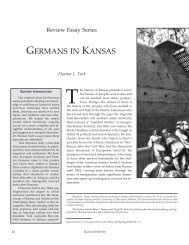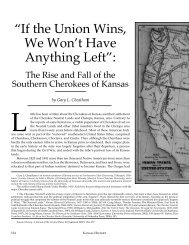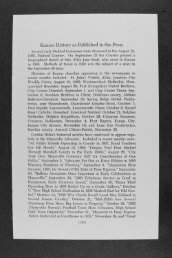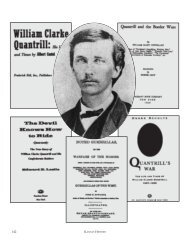July/August 2004 - Kansas Historical Society
July/August 2004 - Kansas Historical Society
July/August 2004 - Kansas Historical Society
You also want an ePaper? Increase the reach of your titles
YUMPU automatically turns print PDFs into web optimized ePapers that Google loves.
11<br />
Cheryl Brown Henderson of the Brown Foundation introduced President George W. Bush at the<br />
dedication of the Brown v. Board National Historic Site. Photo by Donna Rae Pearson.<br />
In the first decades following its construction in 1926,<br />
Topeka’s Monroe School was one of the city’s four<br />
all-black elementary schools. With the landmark 1954<br />
Supreme Court decision striking down the “Separate But<br />
Equal” doctrine, the school gained a place in American<br />
history. Parents of several Monroe students were<br />
plaintiffs in one of the five school desegregation cases<br />
combined into Oliver L. Brown et al. v. Board of Education<br />
of Topeka, <strong>Kansas</strong> et al.<br />
Amid the changes that followed the Brown ruling, the<br />
school building would have been lost had it not been for<br />
a group of dedicated volunteers. On May 17, <strong>2004</strong>,<br />
Monroe School once again received national attention<br />
with its dedication as the Brown v. Board of Education<br />
National Historic Site. The dedication represented not<br />
only a reflection on five decades of struggle toward<br />
equality, but also a celebration of the preservation of the<br />
historically significant Monroe School.<br />
In the school’s original design, Thomas Williamson,<br />
arguably Topeka’s best regarded twentieth-century<br />
architect, employed reinforced board-formed concrete<br />
slabs, beams, and joists to create a structure that would<br />
stand the test of time. However, the building nearly did<br />
not survive its first half-century. In the years following<br />
Brown v. Board, African-American students began<br />
enrolling in traditionally white schools; white students,<br />
however, did not enroll in the city’s traditionally black<br />
schools. The trend resulted in a precipitous decline in<br />
Monroe’s enrollment, which remained entirely African<br />
American. In 1958, just four years following the landmark<br />
case, the school’s enrollment had fallen to 148, approximately<br />
one-third its capacity. Faced with the sharp decline<br />
in enrollment, the school district closed Monroe in 1975.<br />
From the time of its closure, the school’s future<br />
became progressively more uncertain. A 1970s rezoning of<br />
the surrounding neighborhood from residential to light<br />
industrial/commercial seemed to seal the neighborhood’s<br />
fate, making it doubtful the building would ever again be<br />
used as a school. (Ironically, the school district then<br />
constructed a new science magnet school just one block to<br />
the north in 1995.)<br />
The school district used the building for storage until<br />
1980 when it sold the building to Richard Appelhans.<br />
Appelhans then sold the building in 1982 to Fairlawn<br />
Church of the Nazarene, which began remodeling the<br />
building for use as a dental clinic, clothing bank, and a<br />
halfway house. To accommodate the new use, the church<br />
made many changes to the building’s interior, from<br />
The background on pages 11 and 12 and the front cover image of Monroe School<br />
soon after its construction are provided courtesy of the National Park Service.<br />
Brown v<br />
Culmina<br />
Fifty years ago, T<br />
brought national<br />
segregation. No<br />
Brown v. Board<br />
Historic Site,<br />
interpret the de<br />
future













